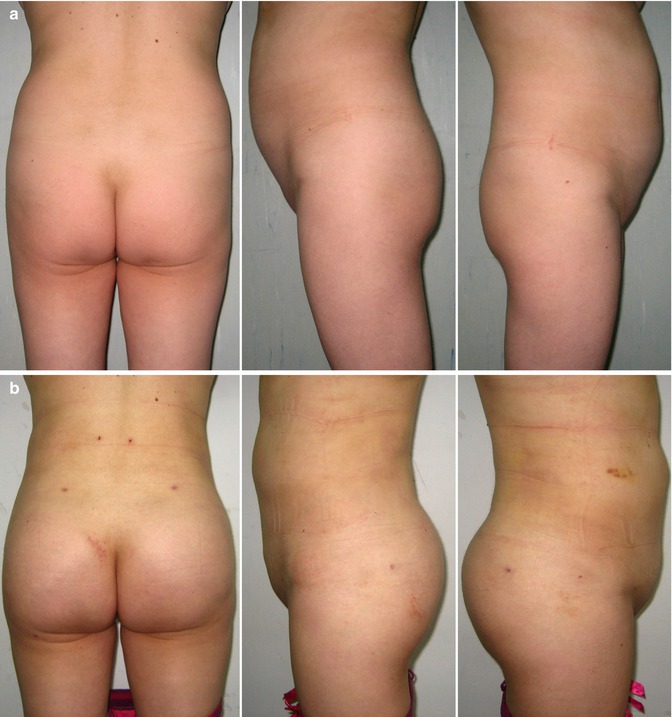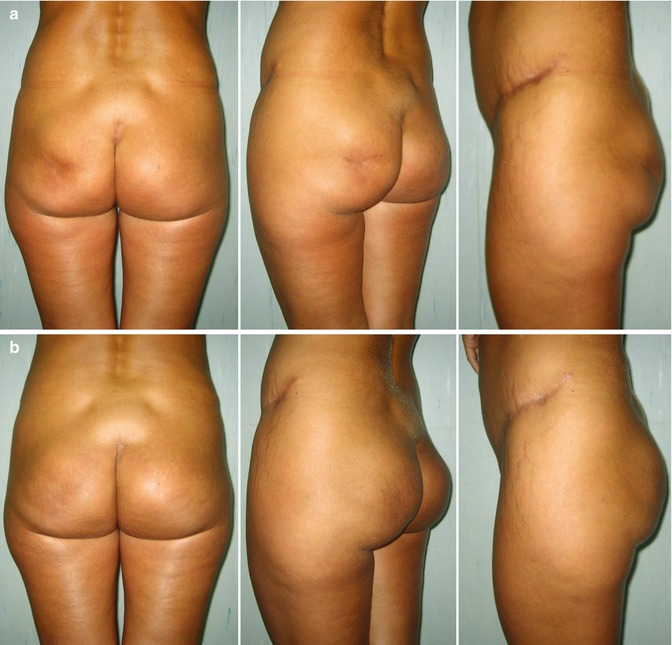
Fig. 45.1
(a) Preoperative 30-year-old female presented for buttock asymmetry following a congenital hip luxation. She showed great frustration by her left buttock being much smaller than the left one. (b) Liposuction of the abdomen, flanks, and lower back was performed and fat obtained. (c) Four months after, lipoinjection was performed to the left buttock for a total of 400 mL of fat. (d) Fourteen months postoperative shows, minimal fat resorption after only one session of fat grafting was shown. The patient is very satisfied with the result

Fig. 45.2
(a) Preoperative 35-year-old female with buttock hypoplasia and slight asymmetry. (b) Three weeks postoperative after 300 mL fat grafting to the left buttock and 400 mL to the right buttock. The patient was very satisfied

Fig. 45.3
A 38-year-old female presented for subcutaneous implants explantation due to left mid buttock skin thinning and almost implant extrusion. (a) Three months after explantation, before lipoinjection, a depression in the left mid buttock is obvious. (b) Twelve months after 200 mL fat transfer to left mid buttock. Buttock symmetry, shape, and skin texture improvement are noticed
45.6 Complications
Fat grafting complications include the usual swelling, bruising, loss of volume over time, and seroma in the harvested sites (especially lower back and sacrum). Seroma is prevented if drains are used. Less common complications include hematoma, cellulitis, fibrosis, oil cysts, sterile abscesses from fat necrosis, symptomatic hypovolemia when large volumes of fat are aspirated[15], calcifications, and septic shock [4]. Rarer and more serious complication is fat emboli. Hypertrophy of the transplanted fat has been observed especially if it had been harvested from the abdomen. Major complications are avoided if less than 1,000 mL of fat is transplanted to each buttock [2].
45.7 Discussion
Autologous fat grafting has been used for a long time to fill various soft tissue defects for either a reconstructive or cosmetic purpose. It is a very convenient, minimally invasive method associated with low morbidity, compared to other techniques (solid or injectable implants, local flaps, or free-tissue transfers). Being autologous, it is noncarcinogenic and nonimmunogenic; the process of harvesting is rather simple, and in most patients appropriate quantities for harvesting can be found. The scarring is minimal at the recipient and donor sites, and patients are generally satisfied with the results. It enables larger volume augmentation than implants. Silicone implants cannot achieve lateral thigh or buttock fullness as some patients may desire. If put under the muscle or intramuscular, the maximum projection obtained is in the upper and mid buttock only; if put under the fascia, the maximum projection is in the lower and mid buttock only. Fat grafting allows obtaining the maximum projection in any area the surgeon considers best for the patient. In buttocks asymmetry fat injection is almost always performed, as implants cannot achieve symmetric results. Liposuctioning the lower back, sacral area, hips, and flank allows an emphasis of the fullness of the buttocks, which cannot be obtained with silicone implants [16]. Fat grafting is less painful and allows a faster recovery with less risk of complications, although the procedure is longer. The main drawback, however, of fat transplantation is the inconsistency of the results because of its resorption. Some of the adipocytes undergo apoptosis and conversion to fibrotic tissue until vascularization from the recipient bed through diffusion takes place. The reported rates of resorption are very variable in the literature—from 30 to 70 % [2, 10, 14] which makes the results unpredictable on the long term, requiring repeat grafting procedures. However, in contrast with the face, where autologous fat transplanted seems to have rather high resorption rates, Mendieta [9] believes that 80–85 % of injected fat in the buttocks survives at 2 years. Long-term survival of buttock grafting of 5 to even 7 years has been reported [17], and the average fat tissue loss in the buttocks was found to be much lower than in the face—between 25 and 35 % [18]. This variability depends on several factors: harvesting procedure, recipient bed, centrifugation speed [19], age of the patient, motion in the recipient site, scarring, radiation, and preparation method [10, 14]. Cannulas used for fat harvest depend on surgeon’s preference—they have diameters between 3 and 5 mm and different tips. The method of harvest differs as well—some surgeons believe that decantation alone is the safest method to preserve cells’ viability [13], while others prepare the fat in different ways. Injection cannulas used are 2, 3, or even 5 mm in diameter, according, again, to different opinions (smaller cannulas to deliver small particles of fat [8, 15, 20], larger cannulas to minimize destruction of fat cells [13]). With so many variables it is not surprising that so many controversies exist among surgeons and that there is no consensus regarding harvesting, preparation, and implantation of the fat grafts.
It is, however, generally accepted that traumatic methods of harvesting, processing, and injecting lead to cellular death. Coleman introduced his lipostructure technique which uses microinjection of fat [20]. His technique has been adopted by many surgeons and consists in meticulous injections of very small aliquots through multiple access sites and in multiple layers and tunnels through a fanning technique. In order to survive, the fat grafts have to be handled in the most atraumatic manner possible so that most of the fat has a nearby source of blood supply and liponecrosis be avoided. Intramuscular injection increases fat survival, and excess fat should not be injected in only one spot.
Stay updated, free articles. Join our Telegram channel

Full access? Get Clinical Tree








